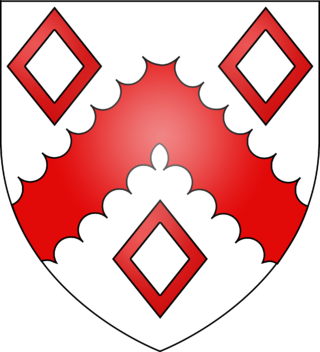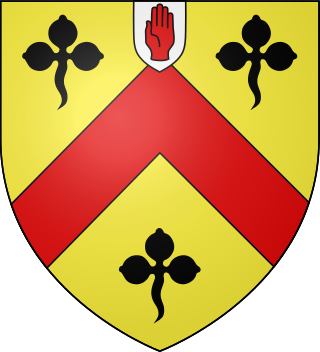
Earl of Galloway is a title in the Peerage of Scotland. It was created in 1623 for Alexander Stewart, 1st Lord Garlies, with remainder to his heirs male bearing the name and arms of Stewart. He had already been created Lord Garlies in the Peerage of Scotland in 1607, with remainder to the heirs male of his body succeeding to the estates of Garlies. This branch of the Stewart family were distant relatives of the Stewart Kings of Scotland.

Earl of Romney is a title that has been created twice.

Earl of Cromartie is a title that has been created twice, both for members of the Mackenzie family. It was first created as Earl of Cromarty in the Peerage of Scotland in 1703 for Sir George Mackenzie, 2nd Baronet, but his titles were forfeited after the Jacobite rising of 1745. It was recreated in 1861 in the Peerage of the United Kingdom for Anne Sutherland-Leveson-Gower, Duchess of Sutherland. Since 1979, the Earl of Cromartie has been chief of Clan Mackenzie.

Earl of Sussex is a title that has been created several times in the Peerages of England, Great Britain, and the United Kingdom. The early Earls of Arundel were often also called Earls of Sussex.

Peregrine Bertie, 2nd Duke of Ancaster and Kesteven, styled The Honourable Peregrine Bertie between 1686 and 1704, Lord Willoughby de Eresby between 1704 and 1715 and Marquess of Lindsey between 1715 and 1723, was a British politician who sat in the House of Commons from 1708 until 1715 when he was called to the House of Lords.
The Echlin Baronetcy, of Clonagh in the County of Kildare, was a title in the Baronetage of Ireland. It was created on 17 October 1721 for Sir Henry Echlin, 2nd Baron of the Court of Exchequer (Ireland). He was the great-grandson of the Right Reverend Robert Echlin, Bishop of Down and Connor between 1613 and 1635. The title became dormant on the death of the tenth Baronet in 2007.

The Wedderburn, later Ogilvy-Wedderburn Baronetcy, of Balindean in the County of Perth, is a title in the Baronetage of the United Kingdom created in 1803.
The Pasley Baronetcy, of Craig in the County of Dumfries, is a title in the Baronetage of Great Britain. It was created on 1 September 1794 for the prominent Scottish naval commander Thomas Pasley, with remainder to the male issue of his daughters. On his death in 1808 he was succeeded according to the special remainder by his grandson Thomas Sabine, who the following year assumed by Royal Licence the surname of Pasley in lieu of his patronymic; he was also a distinguished naval commander. The fifth Baronet was a literary scholar. The family surname is pronounced "Paisley".

The Buckworth, later Buckworth-Herne, later Buckworth-Herne-Soame Baronetcy, of Sheen in the County of Surrey, is a title in the Baronetage of England. It was created on 1 April 1697 for John Buckworth, High Sheriff of London in 1704. The second Baronet sat as Member of Parliament for Weobley. The third Baronet was Assistant Gentleman Usher to George II. The fifth Baronet was Gentleman-Pensioner and Exon of the Guard during the reign of George III. He married Anne, daughter of Paston Herne, of Haveringland Hall, Norfolk, and assumed by Royal licence the additional surname of Herne. The sixth Baronet assumed in 1806 by Royal licence the additional surname of Soame in compliance with the will of Sir Peter Soame, 4th Baronet, of Thurlow. The ninth Baronet was a member of the Shropshire County Council.
There have been three baronetcies created for persons with the surname Maitland, two in the Baronetage of Nova Scotia and one in the Baronetage of the United Kingdom. Two of the creations are extant as of 2008 while the other is either dormant or extinct.

The Spring Baronetcy, of Pakenham in the County of Suffolk, is a title in the Baronetage of England.

The Oglander Baronetcy, of Nunwell in the County of Southampton, was a title in the Baronetage of England. It was created on 12 December 1665 for William Oglander, Member of Parliament for Yarmouth and Newport. The sixth Baronet was member of parliament for Bodmin. The title became extinct on the death of the seventh Baronet, Sir Henry Oglander, in 1874. He left the Nunwell estate to his cousin John Henry Glynn, who, in compliance with Sir Henry's will, took the name of Oglander by royal licence in 1895, and was the possessor of Nunwell as of 1912.

The Nelthorpe baronetcy, of Grays Inn in the City of London, was a title in the baronetage of England. It was created on 10 May 1666 for John Nelthorpe. The fifth baronet was High Sheriff of Lincolnshire in 1741, the sixth baronet High Sheriff in 1767, the seventh baronet in 1800 and the eighth baronet in 1842. The title became extinct on the death of the last in 1865.
The Rochead Baronetcy, of Inverleith in the County of Edinburgh, was a title in the Baronetage of Nova Scotia. It was created on 4 June 1704 for James Rochead. The title became dormant on the death of the second Baronet in 1743.
The Sands Baronetcy, of Blackhall, Kildare, was a title in the Baronetage of Ireland. It was created on 21 December 1676 for William Sands, High Sheriff of Kildare at the time. The title became extinct on the death of the second Baronet in circa 1704.

The Fludyer Baronetcy, of The City of London, was a title in the Baronetage of Great Britain. It was created on 14 November 1759 for the merchant, banker and politician Sir Samuel Fludyer, with remainder in default of male issue of his own to his brother Thomas Fludyer and his issue male. The second Baronet was Member of Parliament for Aldborough. The title became extinct on the death of the fifth Baronet in 1922.

Earl Tylney, of Castlemaine in the County of Kerry, was a title in the Peerage of Ireland. It was created on 11 June 1731 for Richard Child, 1st Viscount Castlemaine. The Child family descended from the merchant, economist and colonial administrator Josiah Child, who on 16 July 1678 was created a baronet, of Wanstead in the County of Essex, in the Baronetage of England. The first Baronet was succeeded by his son from his second marriage, Sir Josiah Child, 2nd Baronet.
The Bromfield Baronetcy, of Southwark in the County of Surrey, was a title in the Baronetage of England. It was created on 20 March 1661 for John Bromfield. The second Baronet was High Sheriff of Surrey in 1689. The title became either extinct or dormant on the death of the third Baronet in 1733.
The Cordell Baronetcy, of Long Melford in the County of Suffolk, was a title in the Baronetage of England. It was created on 22 June 1660 for Robert Cordell, subsequently Member of Parliament for Sudbury. The second Baronet represented Sudbury and Suffolk in Parliament while the third Baronet briefly represented Sudbury. The title became extinct on the latter's death in 1704.

The Abdy baronetcy, of Felix Hall, in the County of Essex, was created in the Baronetage of England on 14 July 1641 for Thomas Abdy who was High Sheriff of Essex. The title became extinct in 1868.











